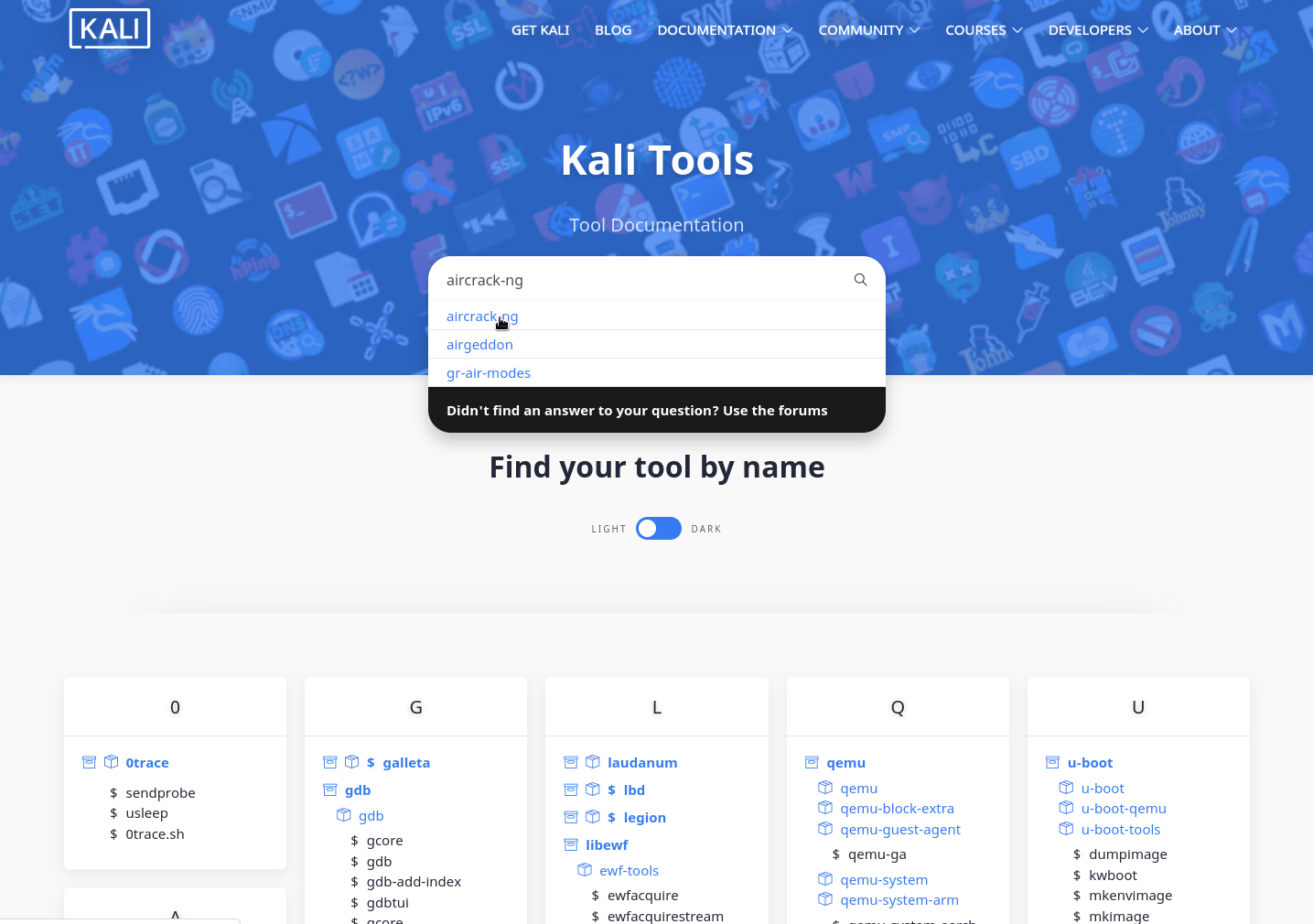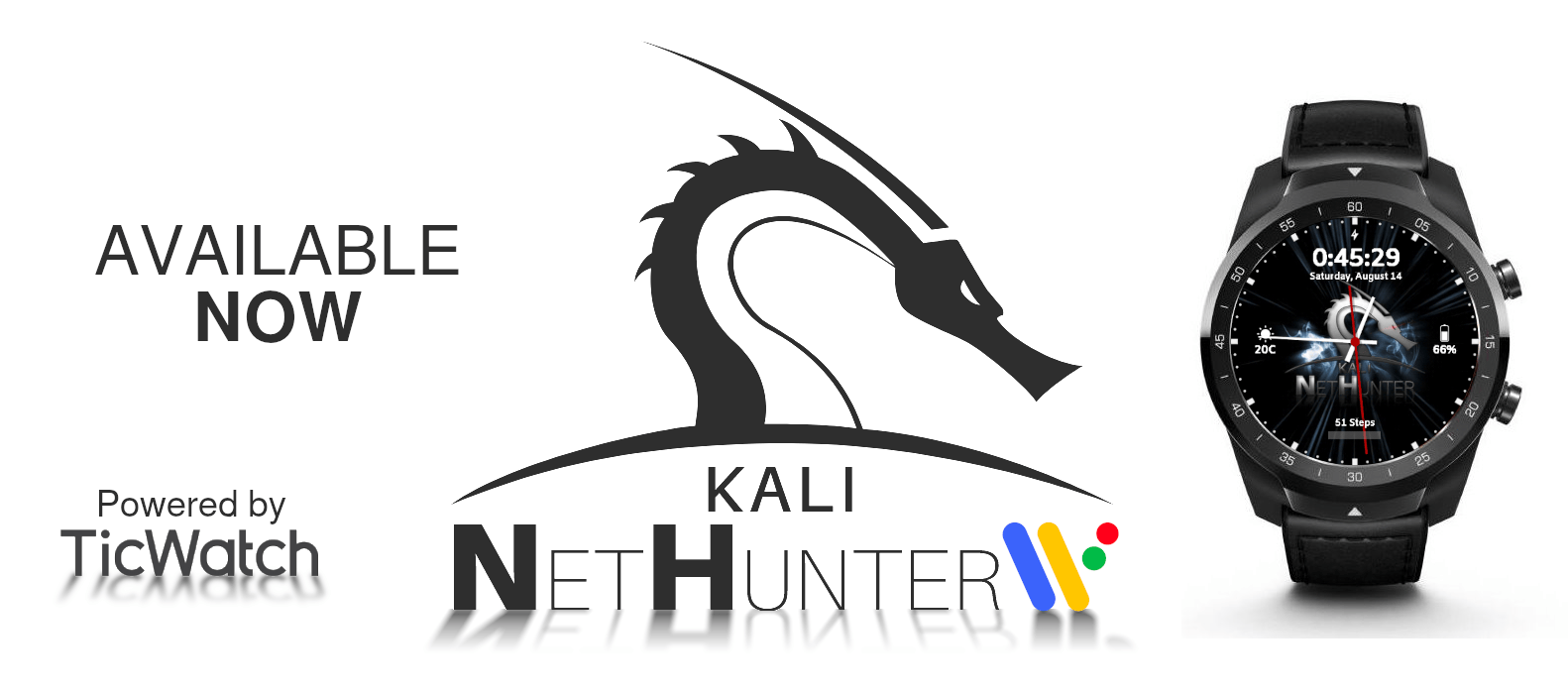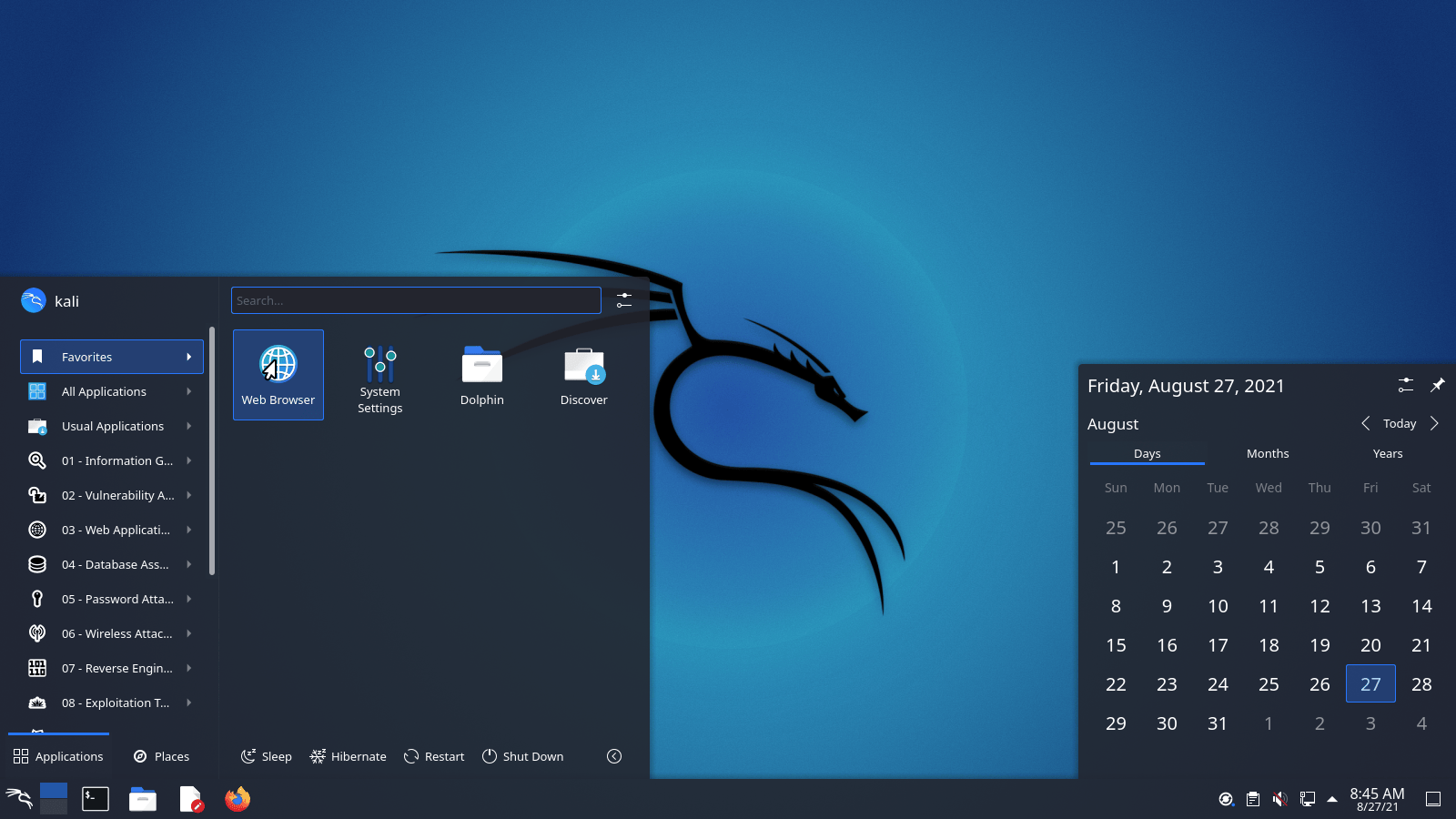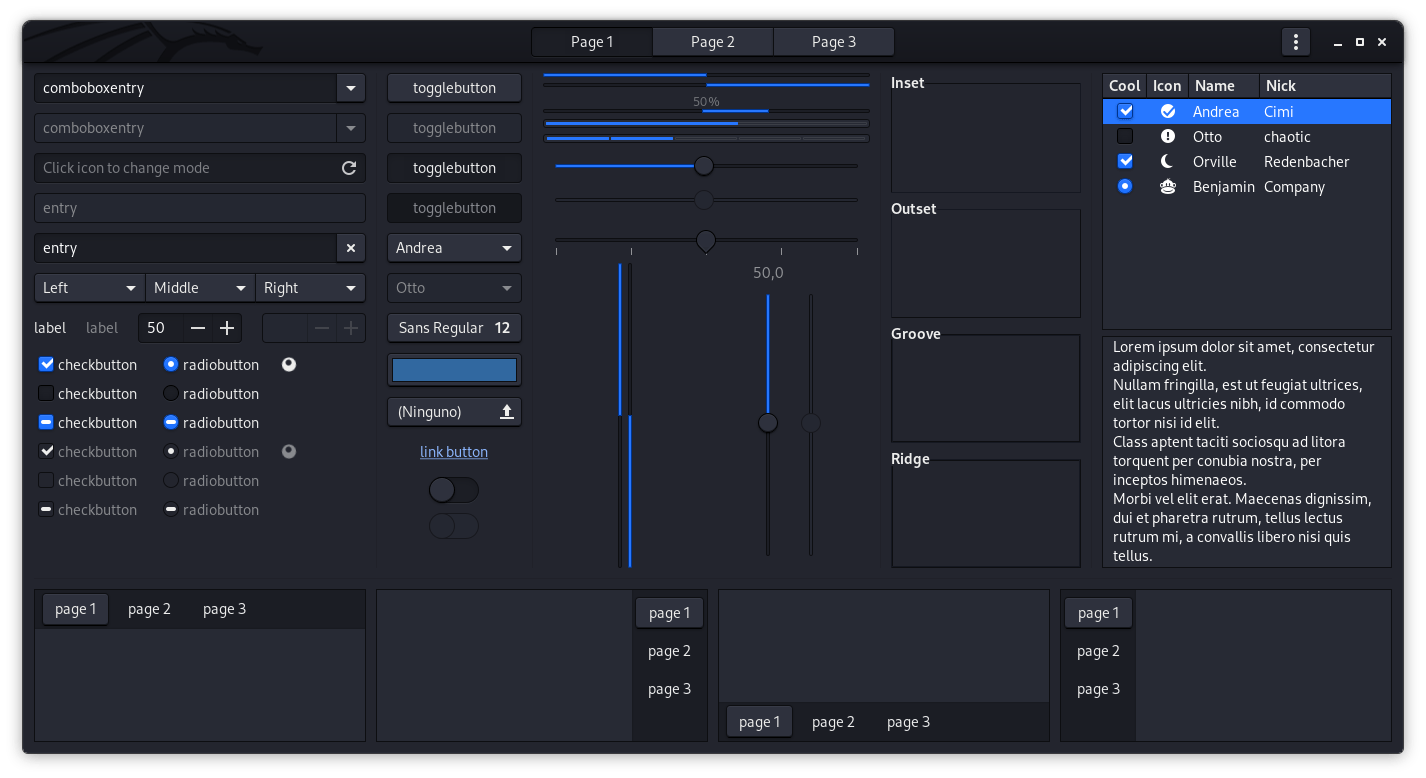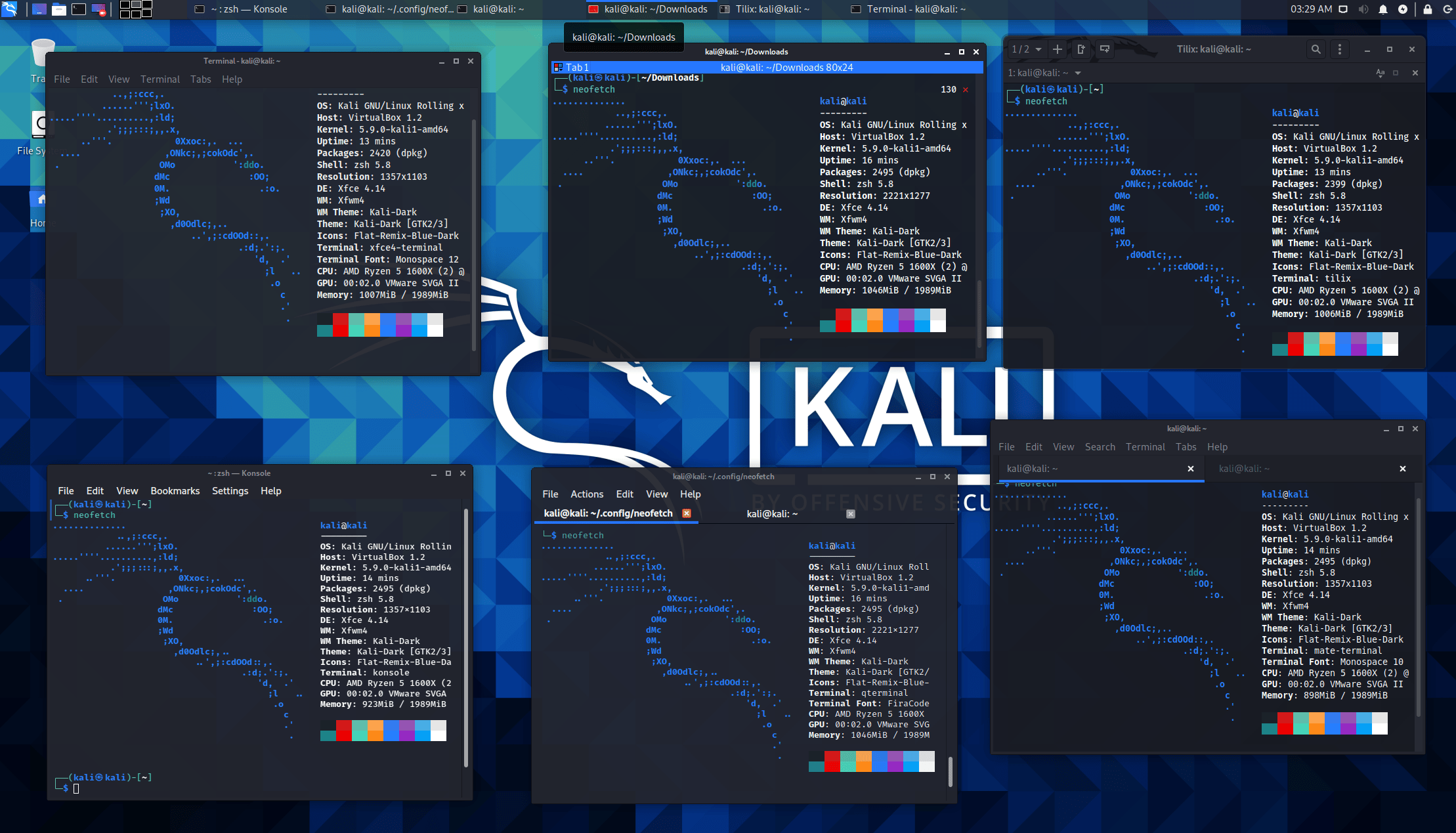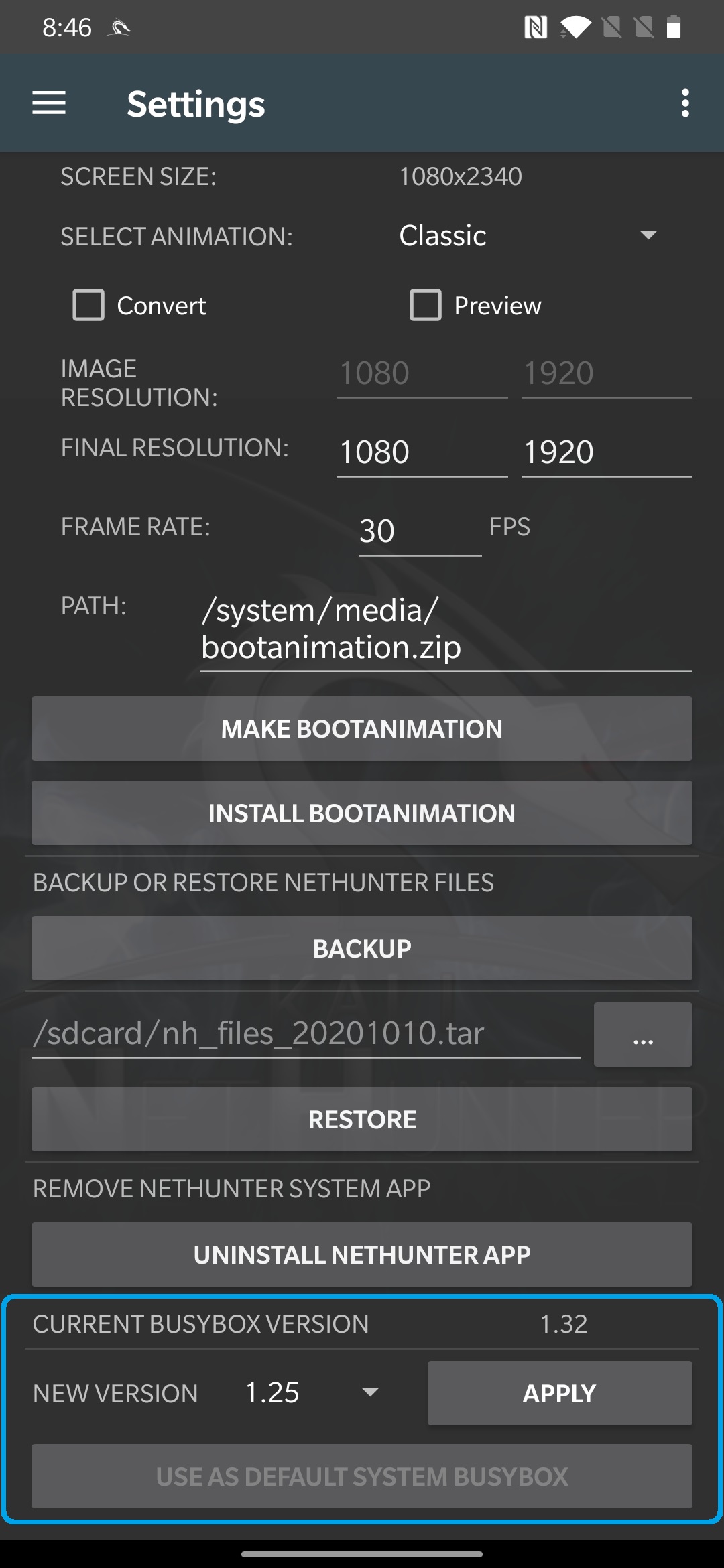- Kali Linux 2021.3 Release (OpenSSL, Kali-Tools, Kali Live VM Support, Kali NetHunter Smartwatch)
- OpenSSL: wide compatibility by default
- Kali-Tools
- Virtualization: improvements all over the place
- New Tools in Kali
- Kali NetHunter Updates
- Kali NetHunter Watch
- Kali NetHunter Installation via Magisk
- Kali NetHunter installation step-by-step guide for our preferred device, the OnePlus 7
- Kali ARM Updates
- Desktop & Theme Updates
- Kali-Docs Updates
- GitLab Commit 2021
- Ampere & ARM
- Upcoming Changes
- Download Kali Linux 2021.3
- Kali Linux 2021.1 Release (Command-Not-Found)
- Xfce & KDE Updates
- Terminals Tweaks
- Finding Commands That Didn’t Want To Be Found
- Partnerships with Tools Authors
- New Tools in Kali
- Kali’s Website
- Wallpapers
- Kali NetHunter Updates
- Kali ARM Updates
- Download Kali Linux 2021.1
Kali Linux 2021.3 Release (OpenSSL, Kali-Tools, Kali Live VM Support, Kali NetHunter Smartwatch)
Today we have released the newest version of Kali Linux, 2021.3 (quarter #3), which is now ready for download or updating.
A summary of the changes since the 2021.2 release from June are:
- OpenSSL — Wide compatibility by default — Keep reading for what that means
- New Kali-Tools site — Following the footsteps of Kali-Docs, Kali-Tools has had a complete refresh
- Better VM support in the Live image session — Copy & paste and drag & drop from your machine into a Kali VM by default
- New tools — From adversary emulation, to subdomain takeover to Wi-Fi attacks
- Kali NetHunter smartwatch — first of its kind, for TicHunter Pro
- KDE 5.21 — Plasma desktop received a version bump
OpenSSL: wide compatibility by default
Going forwards from Kali Linux 2021.3, OpenSSL has now been configured for wider compatibility to allow Kali to talk to as many services as possible. This means that legacy protocols (such as TLS 1.0 and TLS 1.1) and older ciphers are enabled by default. This is done to help increase Kali’s ability to talk to older, obsolete systems and servers that are still using these older protocols. This may potentially increase your options on available attack surfaces (if your target has these End of Life (EoL) services running, having then forgotten about them, what else could this uncover?). While this is not a configuration that would be good for a general purpose operating systems, this setting makes sense for Kali as it enables the user to engage and talk with more potential targets.
This setting is easy to modify via the command-line tool kali-tweaks though. Enter the Hardening section, and from there you can configure OpenSSL for Strong Security mode instead, which uses today’s current modern standard allowing for secure communication.
Kali-Tools
In 2019.4 we moved our documentation over to our updated /docs/ page. It’s now finally the turn of our Kali-Tools site!
We have refreshed every aspect of the previous site, giving a new, faster, layout, content, and system! The backend is now in a semi-automated state and more in the open, which like before, allows for anyone to help out and contribute.
Once these sites have settled down from all the changes and matured a bit, we will start to package these both up, allowing for offline reading.
Virtualization: improvements all over the place
The Kali Live image received some love during this release cycle! We worked hard to make the experience smoother for those who run the Live image in virtualized environments. Basic features like copy’n’paste and drag’n’drop between the host and the guest should now work out of the box. And this is really for everyone: VMware, VirtualBox, Hyper-V and QEMU+Spice. Did we forget anyone? Drop us a word on the Kali bug tracker!
On the same line: it’s now very easy to configure Kali for Hyper-V Enhanced Session Mode. Open kali-tweaks in a terminal, select Virtualization , and if Kali is running under Hyper-V, you’ll see a setting to turn on Hyper-V Enhanced Session Mode. It’s now as simple as hitting Enter!
If you use this feature, make sure to visit kali.org/docs/virtualization/install-hyper-v-guest-enhanced-session-mode/, as there are a few additional things to be aware of.
Many thanks to @Shane Bennett, who spent a tremendous amount of time testing this feature, provided extremely detailed feedback all along, and even helped us with the documentation. Kudos Shane!
New Tools in Kali
It wouldn’t be a Kali release if there weren’t any new tools added! A quick run down of what’s been added (to the network repositories):
- Berate_ap — Orchestrating MANA rogue Wi-Fi Access Points
- CALDERA — Scalable automated adversary emulation platform
- EAPHammer — Targeted evil twin attacks against WPA2-Enterprise Wi-Fi networks
- HostHunter — Recon tool for discovering hostnames using OSINT techniques
- RouterKeygenPC — Generate default WPA/WEP Wi-Fi keys
- Subjack — Subdomain takeover
- WPA_Sycophant — Evil client portion of EAP relay attack
Kali NetHunter Updates
Kali NetHunter Watch
We proudly introduce the world’s first Kali NetHunter smartwatch, the TicHunter Pro thanks to the outstanding work of our very own NetHunter developer @yesimxev. It is still experimental, hence the features are limited to USB attacks, and some basic functions. The hardware also has limitations, as such a small battery won’t supply enough voltage for any OTG adapters, so huge antennas won’t stick out of your wrist! The future is very promising, bringing support for Nexmon and internal bluetooth usage.
The image is available on our download page.
Please note that those images contain a “nano Kali rootfs” due to technical reasons. The detailed installation guide can be found in our Kali documentation. Feel free to join the adventure!
Kali NetHunter Installation via Magisk
Thanks to the amazing work of @Mominul Islam, we can now bring Kali NetHunter to Android 11 devices without a fully working TWRP!
Each Kali NetHunter image can be flashed as a Magisk module. This work is still in its infancy and more work is needed to bring it up to par with the traditional installer through TWRP.
One of the missing parts is the kernel installation. We haven’t been able to install the kernel through Magisk yet. That has to be done via kernel installers like the “Franco Kernel Manager”. If you are keen to get NetHunter onto your Android 11 device, just give it a crack. If you are interested in helping out with getting the kernel part finished, please get in touch with us through our GitLab issue tracker. Any help is greatly appreciated!
Kali NetHunter installation step-by-step guide for our preferred device, the OnePlus 7
Our preferred device for Kali NetHunter is the OnePlus 7 running Android 10 (stock ROM).
For a step-by-step installation guide and links to all the files required to restore your phone to the latest stock Android 10 ROM, install TWRP, Magisk and Kali NetHunter, head over to our Kali documentation page.
Kali ARM Updates
We have been busy doing various tweaks and tinkering on our Kali ARM images, which covers:
- Our Kali ARM build-scripts have been re-worked.
- Thanks to @cyrus104, we now have a build-script to support the Gateworks Newport board, and he also added documentation for it.
- @Re4son contributed a build-script for the Raspberry Pi Zero W based “Pi-Tail”(Find more information here).
- Additionally, the RaspberryPi Zero W based “P4wnP1” build-script has undergone some major changes.
- All images should finally resize the file-system on the first boot.
- We now re-generate the default snakeoil cert, which fixes a couple of tools that were failing to run previously.
- Images default to iptables-legacy and ip6tables-legacy for iptables support.
- We now set a default locale of en_US.UTF-8 on all images, you can, of course, change this to your preferred locale.
- The Kali user on ARM images is now in all of the same groups as base images by default, and uses zsh for the default shell. You can change your default shell by using the kali-tweaks tool which also comes pre-installed.
- Raspberry Pi images can now use a wpa_supplicant.conf file on the /boot partition.
- Raspberry Pi images now come with kalipi-config , and kalipi-tft-config pre-installed.
- Pinebook Pro’s kernel has been updated to 5.14, and you now get messages on the LCD screen as it’s booting, instead of a blinking cursor until X starts.
Desktop & Theme Updates
There are also some changes in the desktop space:
- Improved GTK3 theme for Xfce’s notifications and logout-dialog
- Redesigned GTK2 theme for a better fit of older programs
- Improved Kali-Dark and Kali-Light syntax-highlighting themes for GNOME and Xfce
In addition to these changes, one of Kali’s preferred desktops, KDE plasma, has received a version bump, now including version 5.21. This update brings an updated look, with a new application launcher and theme improvements. Here’s a preview of how it looks with Kali’s customization:
Kali-Docs Updates
Our documentation site, as well as the pages mentioned already in this blog post, the following other pages have received major changes:
GitLab Commit 2021
We participated in GitLab’s virtual conference this year and @g0tmi1k gave a talk on the Dynamic between Kali Linux and OffSec. Give it a watch!
Ampere & ARM
Following our announcement of our partnerships with Ampere, we have now fully moved our ARM package building machines over to their hardware, and loving the speed increase! Thank you again to Ampere for the assistance! If you need some ARM servers give them a look! If they are nice enough to help us out this way, we are sure they will treat you good as well.
Upcoming Changes
Looking forward, we are going to be announcing the following changes:
- Kali-Menu refresh — We know you may not use it, but for the people who do, we are planning on making some major alterations in its structure. This will hopefully be live for testing in 2021.4, and then made default in a later release based on user response. You will be able to change the menu layout by using kali-tweaks . If you want to provide input on this change, get engaged with us and make your voice heard!
- Load Balancer (http.kali.org & cdimage.kali.org) — This handles apt packages as well as OS images. We will be switching from MirrorBrain to MirrorBits. We will be soon in touch with all the community mirror maintainers to give them notice of our infrastructure changes. If you would like to become a mirror, please see our guide.
Download Kali Linux 2021.3
Fresh Images: So what are you waiting for? Start downloading already!
Seasoned Kali Linux users are already aware of this, but for the those who are not, we do also produce weekly builds that you can use as well. If you cannot wait for our next release and you want the latest packages (or bug fixes) when you download the image, you can just use the weekly image instead. This way you’ll have fewer updates to do. Just know that these are automated builds that we do not QA like we do our standard release images. But we gladly take bug reports about those images because we want any issues to be fixed before our next release!
Existing Installs: If you already have an existing Kali Linux installation, remember you can always do a quick update:
You should now be on Kali Linux 2021.3. We can do a quick check by doing:
NOTE: The output of uname -r may be different depending on the system architecture.
As always, should you come across any bugs in Kali, please submit a report on our bug tracker. We’ll never be able to fix what we do not know is broken! And Twitter is not a Bug Tracker!
Источник
Kali Linux 2021.1 Release (Command-Not-Found)
Today we’re pushing out the first Kali Linux release of the year with Kali Linux 2021.1. This edition brings enhancements of existing features, and is ready to be downloaded or upgraded if you have an existing Kali Linux installation.
- Xfce 4.16 — Our preferred and current default desktop environment has been updated and tweaked
- KDE 5.20 — Plasma also received a version bump
- Terminals — mate-terminal , terminator and tilix all had various work carried out on them
- Command Not Found — A helping hand to say if a program needs to be installed
- Partnership with more tool authors — BC Security & Joohoi have been producing great tools and we want to support them
- New tools & updates — Multiple new tools have been added to Kali and are ready for you
- Kali NetHunter — New BusyBox & Rucky version, and boot-animation
- Kali ARM — Preliminary support for Parallels on Apple Silicon (Apple M1) & Raspberry Pi 400 (WiFi Support)
The Kali project itself also has a couple different changes:
- New Kali website — You may have noticed a few things looking different
- Kali newsletter — Rather than you coming to us for updates, we can push them to your inbox
Xfce & KDE Updates
How you choose to interact with Kali is completely up to you. You may want to access Kali locally or remotely, either graphically or on the command line. Even when you pick a method, there are still options you can choose from, such as a desktop environment.
By default, Kali uses Xfce, but during the setup process, allows for GNOME, KDE, or no GUI to be selected. After the setup is complete, you can install even more. We have pre-configurations for Enlightenment, i3, LXDE, and MATE as well.
So when a desktop environment gets an update, they often enhance day-to-day activities for their users. It’s best to hear it straight from the authors, for a tour of what’s changed:
Below is our tweaked GTK3 theme, on Xfce:
Terminals Tweaks
When we use Kali, we spend a significant amount of time using the command line. A lot of the time, we do it using a local terminal (rather than in a console or remote SSH). With the options of desktop environments, there are also choices when it comes to the terminals (same with what shell to use). We have been working away on various terminals ( xfce4-terminal , tmux , tilix , konsole , qterminal , and mate-terminal ) to “Kali-fy” them:
Finding Commands That Didn’t Want To Be Found
A while ago, we changed the default set of tools installed in Kali. Most users know they can either install a one-off package, or revert back to the old set of defaults ( apt install kali-linux-large ). But to help communicate our changes (as well as any new tools), we have now included command-not-found by default. This is an “optional” package, which can be removed without removing all of kali-linux-default .
Without command-not-found installed:
If you are wondering “How does this help me?”, or has the above ever happened to you, we like to think people’s next stage would be to do apt-cache search gitleaks and see it in the network repositories. But we can do better. Now with command-not-found :
As you can see from the above example:
- gitleaks — If the command you entered is the name of an executable available in Kali, it will say the package that you need to install (if its not already!)
- gitleakss — If you are “fat fingered” and make a typo, it may make a suggestion
- badcmd — If you typed in an invalid command that doesn’t exist in Kali, it will give the original message of “command not found”.
So, how can I get this magic? Good question! If you’re:
- Doing a fresh install of Kali Linux 2021.1 or later, it will “just happen” during the setup.
- Updating Kali and you are using a Bash shell, then it will “just happen” too.
- Updating Kali and you are using a Zsh shell, you will need to add the following lines to your
But it doesn’t have to end here. By adding COMMAND_NOT_FOUND_INSTALL_PROMPT=1 to your shell’s environment (e.g.
/.zshrc ), command-not-found will take it one step further, and also prompt you if you want to install the missing package. This change is something we will be putting in in a future release.
Partnerships with Tools Authors
Carrying on from our previous partnership with byt3bl33d3r, we have expanded to supporting:
- BC Security — Giving Kali exclusive early access to “Empire” ( powershell-empire ) & “StarKiller”
- Joohoi — The creator of “Fuzz Faster U Fool (ffuf)”
The announcement with Joohoi is new for Kali 2021.1. Like the previous sponsorships, you can either sponsor him directly to get the latest access to ffuf, use Kali Linux, or wait 30 days until the source code becomes public. However, he has also announced anyone who makes a significant contribution, which gets accepted into the project, also gets access!
New Tools in Kali
It wouldn’t be a Kali release if there weren’t any new tools added! A quick run down of what’s been added (to the network repositories):
- Airgeddon — Audit wireless networks
- AltDNS — Generates permutations, alterations and mutations of subdomains and then resolves them
- Arjun — HTTP parameter discovery suite
- Chisel — A fast TCP/UDP tunnel over HTTP
- DNSGen — Generates combination of domain names from the provided input
- DumpsterDiver — Search secrets in various filetypes
- GetAllUrls — Fetch known URLs from AlienVault’s Open Threat Exchange, the Wayback Machine, and Common Crawl
- GitLeaks — Searches Git repo’s history for secrets and keys
- HTTProbe — Take a list of domains and probe for working HTTP and HTTPS servers
- MassDNS — A high-performance DNS stub resolver for bulk lookups and reconnaissance
- PSKracker — WPA/WPS toolkit for generating default keys/pins
- WordlistRaider — Preparing existing wordlists
Kali’s Website
Until recently, the only way you could be reading this would have been from our RSS feed or directly from our blog (as we only recently made the announcement of the Kali Newletter). You may of noticed already, and we said that it was coming, and it finally has — kali.org has had a face-lift!
We have (finally) moved away from WordPress to Hugo. Similarly to Kali, the website will also be a rolling distribution. The recent change is mostly cosmetic and content (both were long overdue), and we have made plans for new features to be added.
Another upside of the switch is that we can take more advantage of what GitLab has to offer. We recently had an interview with GitLab about the switch.
On the subject of interviews, we also had a word with Mr Robot’s ARG Society if you missed that.
Wallpapers
Just a quick little thing, we have tweaked our wallpaper packages:
- kali-wallpapers-2020.4 — Kali’s wallpapers from 2020.4 and onwards (for the time being)
- kali-wallpapers-2019.4 — Kali’s wallpapers between 2019.4 and 2020.3.
- kali-wallpapers-legacy — BackTrack & Kali nostalgic backgrounds
- kali-wallpapers-all — Every wallpaper
- kali-community-wallpapers — created and submitted by the community (submit yours today!)
With the alterations to the packages, we have taken the time to improve support for Xfce when using them.
Kali NetHunter Updates
BusyBox, one of the core engines of Kali NetHunter, has received a well deserved upgrade to version “1.32.0-nethunter”. BusyBox is used internally to ensure that NetHunter tools and commands are executed consistently across the vast number of different Android versions and vendor modifications. This change, whilst big, should go unnoticed by users and will help developers to port their code to NetHunter with no hassles at all. @yesimxev has added a handy section to the settings menu, which allows developers to select different BusyBox versions for testing:
Speaking of developers: If you have any cool ideas you’d like to see included in Kali NetHunter or if you would like to contribute to this amazing project, please reach out to us in our forums or on GitLab. We would love to hear from you!
Tools have been updated to the latest versions, notably Rucky — the “modern looking USB Rubber Ducky Editor and Attack Launcher”, which has been completely re-written by its author @mayankmetha and released in the Kali NetHunter App Store as version 2.1.
We’ve also been busy working on the visual aspects of Kali NetHunter, with @s133py adding a stunning new boot-animation to the growing selection:
If you have a cool boot-animation you’d like to share, please submit a merge request to our Kali NetHunter boot-animation repository.
Kali ARM Updates
As you may have heard, Apple have released new Macs with their own processors, known as Apple Silicon (Apple M1). So far, only Parallels have released something publicly that people can use for virtualization. To that end, we have generated both an installer & live ISOs ( kali-linux-2021.1-installer-arm64.iso and kali-linux-2021.1-live-arm64.iso ) that can be used with VMs on Apple Silicon Macs. Many thanks to the people who reached out and offered to test and helped us to iron out the bugs. If you’d like to see it in action, David Bombal has put out a video of it.
We have also added support for the Raspberry Pi 400’s wireless card, however it is very important to note that this is not a nexmon firmware, as nexmon does not currently support it.
The Kali ARM build scripts have seen a few more improvements from Francisco Jose Rodriguez Martos and we appreciate the assistance greatly. If you’d like to get involved with ARM, check out the GitLab issue list.
Download Kali Linux 2021.1
Fresh Images: So what are you waiting for? Start downloading already!
Seasoned Kali Linux users are already aware of this, but for the ones who are not, we do also produce weekly builds that you can use as well. If you cannot wait for our next release and you want the latest packages (or bug fixes) when you download the image, you can just use the weekly image instead. This way you’ll have fewer updates to do. Just know that these are automated builds that we do not QA like we do our standard release images. But we gladly take bug reports about those images because we want any issues to be fixed before our next release!
Existing Installs: If you already have an existing Kali Linux installation, remember you can always do a quick update:
You should now be on Kali Linux 2021.1. We can do a quick check by doing:
NOTE: The output of uname -r may be different depending on the system architecture.
As always, should you come across any bugs in Kali, please submit a report on our bug tracker. We’ll never be able to fix what we do not know is broken! And Twitter is not a Bug Tracker!
Источник
